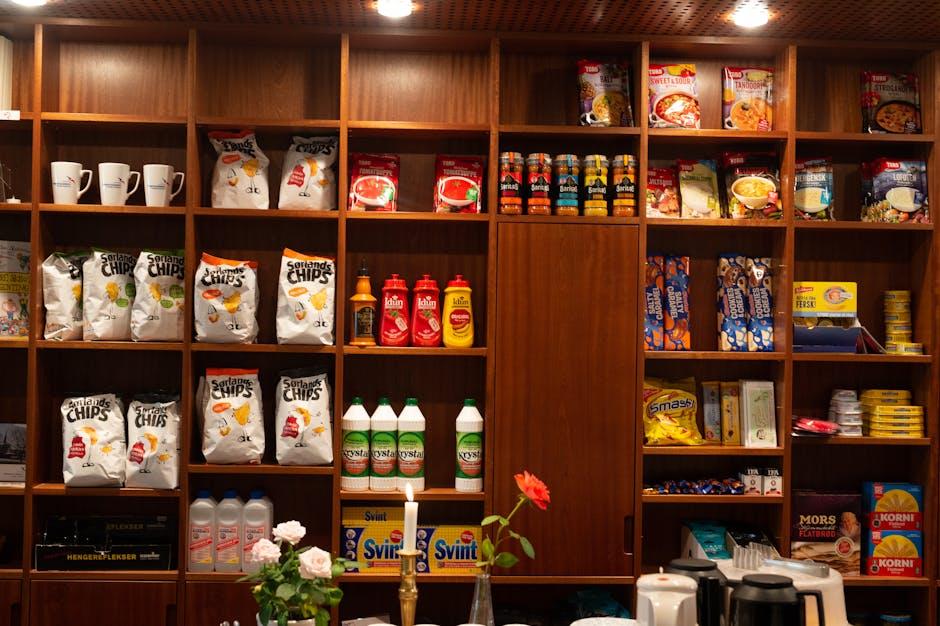In a world where every penny counts, mastering the art of budget-friendly grocery shopping can transform your monthly expenses and bring a welcome sense of control to your kitchen routine. Whether you’re a seasoned saver or just beginning to navigate the aisles with an eye on your wallet, discovering clever hacks for stretching your food budget can make all the difference. From savvy planning and smart shopping strategies to uncovering hidden deals, these practical tips are designed to help you fill your cart without emptying your bank account. Let’s explore how thoughtful choices and a little resourcefulness can turn grocery shopping from a chore into an empowering-and economical-experience.
Smart Planning Techniques for Maximum Savings

Implementing a strategic approach to grocery shopping can transform your budget and reduce waste significantly. One key method is to plan meals around weekly sales and seasonal produce. Many stores release their promotions ahead of time, allowing you to align your shopping list with items that offer the biggest discounts. Combining this with the habit of using a shopping list prevents impulse buys and ensures you pick exactly what’s necessary. Another savvy technique is to prepare meals in bulk and freeze portions for later-this not only saves money but also minimizes food spoilage and last-minute takeout costs.
Creating a shopping calendar can also provide clarity and discipline, helping you avoid multiple trips that often lead to overspending. Consider categorizing items by price, freshness, and shelf life, as illustrated in the table below. When you organize your purchases thoughtfully, you prioritize buying in bulk for staples with a longer shelf life, while making room in your weekly budget for fresh ingredients. Use this simple framework to guide your decisions and watch your savings grow:
| Category | Examples | Purchase Frequency | Cost-Saving Tip |
|---|---|---|---|
| Long-lasting staples | Rice, pasta, canned goods | Monthly | Buy in bulk during sales |
| Fresh produce | Seasonal fruits, vegetables | Weekly | Choose local and seasonal items |
| Perishables | Dairy, bread, meat | 2-3 times/week | Plan meals to use fresh items quickly |
Navigating Store Layouts to Find Hidden Deals

Understanding store layouts is a clever way to uncover deals that aren’t loudly advertised. Many grocery stores design their aisles to encourage browsing, placing staple items like bread and milk at the back. This intentional layout nudges shoppers past tempting seasonal displays and clearance racks. To capitalize on this, start your trip with a mental map: check clearance aisles, end caps, and overstock sections where stores sneak hidden markdowns. Don’t hesitate to ask staff for tips on where weekly discounts or unmarked sales might be located-often, that insider knowledge leads to surprising savings.
While navigating aisles, keep an eye out for specific shelf placements that generally signal a bargain. For example:
- Eye-level shelves: Typically reserved for premium or new products.
- Bottom and top shelves: Where value items and discounts often lurk.
- End caps: Perfect spots for limited-time offers and seasonal specials.
Below is a quick reference guide to help decode where deals are frequently found:
| Store Area | Deal Likelihood | Tip |
|---|---|---|
| End caps | High | Scan weekly circular items here |
| Near registers | Medium | Look for clearance snacks and impulse buy deals |
| Behind staple aisles | Variable | Check for unmarked markdowns on overlooked goods |
Essential Pantry Staples That Stretch Your Dollar

Stocking your pantry with versatile staples is a clever way to maximize every grocery dollar. Items like dried beans, rice, and pasta serve as the foundation for countless meals, offering both nourishment and flexibility. Canned tomatoes and frozen vegetables add convenience without compromising nutrition, allowing you to whip up hearty dishes even when fresh produce isn’t on sale. Incorporating oats and flour into your cart can open doors to homemade breads, breakfasts, and desserts, stretching your ingredients further than pre-packaged options ever could.
Consider keeping these essentials on hand for recipes ranging from quick weeknight dinners to slow-simmered stews. The power of pantry staples lies in their longevity and cost-effectiveness, helping avoid impromptu takeout runs. For easy reference, here’s a quick rundown of dependable items to keep within arm’s reach:
- Dried Legumes: Chickpeas, lentils, black beans
- Grains & Flours: Brown rice, rolled oats, whole wheat flour
- Canned Goods: Tomatoes, coconut milk, tuna
- Frozen Essentials: Mixed vegetables, spinach, berries
- Spices & Oils: Olive oil, garlic powder, chili flakes
| Pantry Item | Average Cost | Storage Life |
|---|---|---|
| Dried Beans (1 lb) | $1.50 | 12 months |
| Brown Rice (1 lb) | $1.20 | 6-12 months |
| Canned Tomatoes (14 oz) | $0.90 | 18 months |
| Frozen Vegetables (16 oz) | $1.75 | 8-12 months |
| Olive Oil (16 oz) | $5.00 | 18-24 months |
Creative Meal Prep Ideas Using Budget Ingredients

Stretch your budget further by embracing versatile ingredients that transform into multiple meals throughout the week. For instance, a simple batch of beans can become a hearty chili, a zesty salad topper, or a smooth hummus spread. Incorporate seasonal vegetables and whole grains like brown rice or quinoa-they’re affordable, nutritious, and perfect for creating colorful bowls or wrap fillings. Utilizing spices and herbs you already have on hand can elevate these humble ingredients to restaurant-quality dishes without increasing your grocery bill.
Implementing smart storage and prep techniques will also save time and reduce waste. Consider batch cooking staple components such as roasted vegetables, grilled chicken, or pasta in advance, which can be mixed and matched throughout the week for variety. Here’s a quick guide to simple prepped items and their meal uses:
| Prepped Ingredient | Meal Uses |
|---|---|
| Roasted Sweet Potatoes | Salad topping, taco filling, mashed side |
| Hard-Boiled Eggs | Breakfast toast, salad protein, quick snacks |
| Cooked Lentils | Soups, veggie patties, grain bowls |
| Steamed Broccoli | Stir-fries, pasta add-in, mixed with rice |
- Double up: Cook double portions and freeze what you won’t eat immediately.
- Mix and match: Rotate proteins and veggies with grains to prevent boredom.
- Use leftovers creatively: Transform last night’s dinner into today’s lunch with minimal effort.
The Conclusion
Mastering the art of budget-friendly grocery shopping is less about sacrifice and more about savvy choices. With a bit of planning, keen awareness, and these simple hacks in your toolkit, you can stretch every dollar without compromising quality or taste. Remember, the best savings come not just from slashing prices, but from smart decisions that turn every trip to the store into an opportunity-proof that frugality and flavor can walk hand in hand. Happy shopping, and here’s to filling your cart and your kitchen with both value and variety!











